Luftwaffe scourge. British Supermarine Spitfire fighters
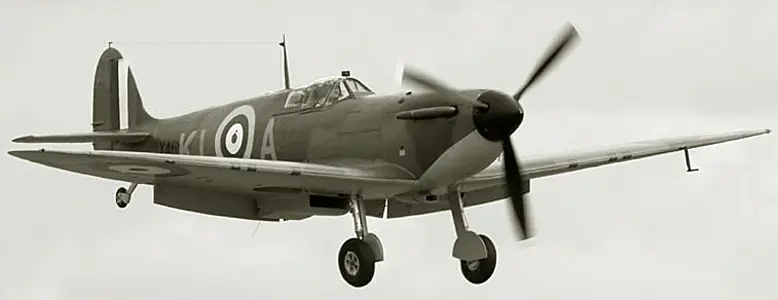
Spitfire in flight
“Spitfires fell to the ground, touched the sea, pierced trees, cut telegraph and high-voltage wires, collided in the air, flew into pieces, their rudders and parts of the wings fell off, and they still made safe landings, from the wheel,” – this is what the Australian pilot of this fighter, John Vader, wrote in his book Spitfire.
When the Battle of Britain was in full swing, Hermann Goering at a meeting of the Luftwaffe High Command (Oberkommando der Luftwaffe), reproaching the leadership for their inability to defeat the Royal Air Force (RAF) and achieve complete air superiority, asked what else they needed to ensure complete victory in the air, to which the young German ace pilot Adolf Galland* He answered him rather boldly: “A squadron of Spitfires!” That was the reputation Supermarine Spitfire.
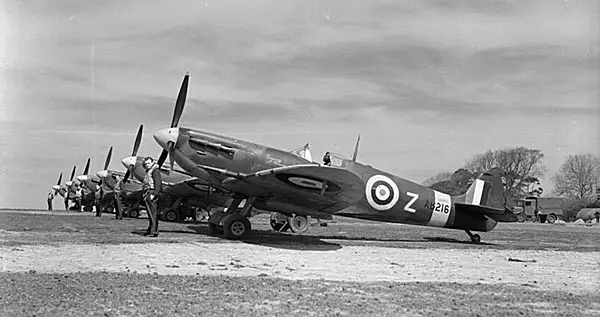
Squadron of Spitfires. Photo: Imperial War Museum
The Second World War is the most terrible and bloody war, in which over 50 million people died, and left behind historical memory of many generations of people has a clear trace, so it is not surprising that weapon, which soldiers fought in this war also became legendary, and its fighting qualities have been discussed for several post-war generations.
Such weapons for us, undoubtedly, are the T-34 tank and the legendary Katyusha; for the American military, the no less legendary Aircobra fighter (P-39 Airacobra) and the battleship Missouri (USS Missouri), at which the surrender of militaristic Japan was signed on September 2, 1945, but for Great Britain the symbol of victory in this bloody war was the Royal Air Force fighter Spitfire - a masterpiece of aerodynamic technology, which was among the best fighters of the Second World War and became for the people of Britain a symbol of faith in victory in the most difficult days of the war!
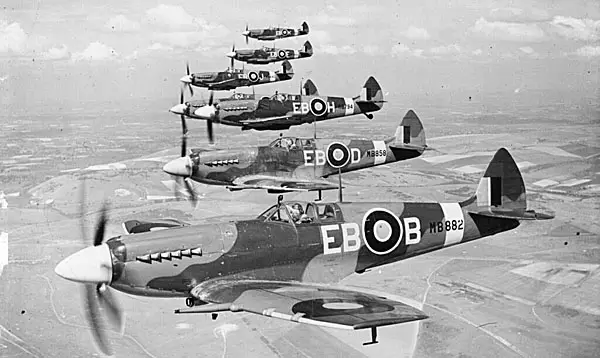
Spitfire squadron in service (Supermarine Spitfire Mk XII)
Indeed, its capabilities and adaptability were so great that it was the only fighter aircraft produced before, during and after the end of World War II. The Spitfire first flew on March 5, 1936; it entered service with the Royal Air Force in 1938 and remained in service until 1955. A total of 20 such fighters were built.
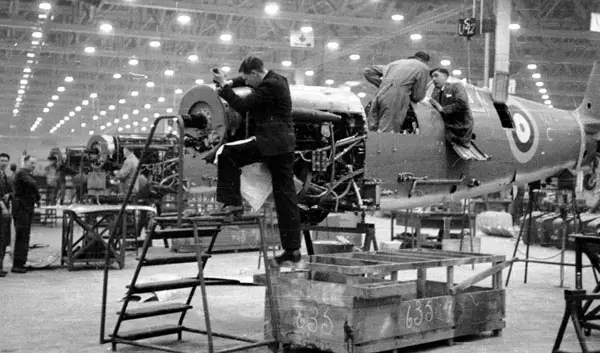
Spitfire assembly plant in Woolston (Hampshire)
But let's start from the beginning...
In the beginning there were steam locomotives...
One of the most significant events in his life was probably that he learned to draw well, which played a big role in his later life and career. After leaving school as a draftsman, he found his way to a steam locomotive manufacturing plant, where he developed intricate drafting techniques and helped design the draft locomotives that still ride on the roads of the United Kingdom today.
Ultimately, by the age of twenty-three, he had developed a fairly high professional reputation, and he was invited to join the company Supermarine Aviation Works*, which was very recently founded in Southampton and specialized in the production of naval aircraft.
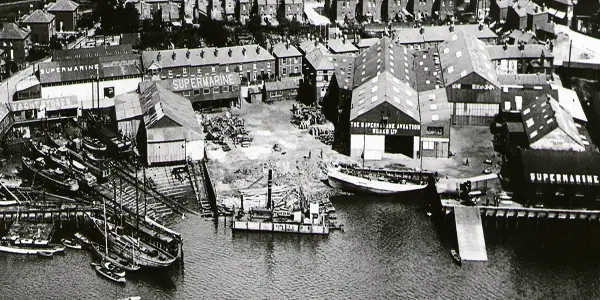
Production workshops of Supermarine Aviation Works, which produces seaplanes
He is Reginald Joseph Mitchell*, the head of the team of designers who developed the legendary Supermarine Spitfire fighter, born in 1895, long before any aircraft equipped with an internal combustion engine took to the air. And during the years that R. J. Mitchell worked for the company Supermarine, he managed to design 24 models of various aircraft (most of them were seaplanes).
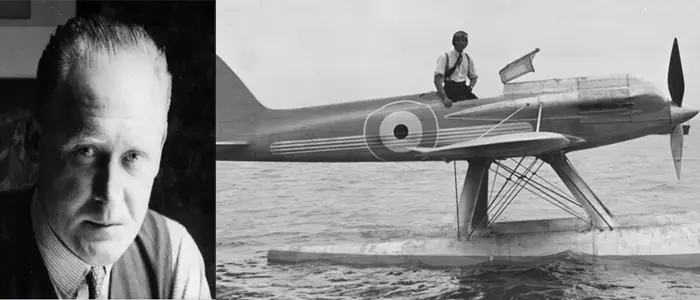
Reginald Joseph Mitchell, head of the design team that developed the legendary Supermarine Spitfire fighter
Then seaplanes...
A huge role in the fate of the Spitfire was played by the so-called Schneider Cup - a competition held since 1912, where the main task of its participants was to show maximum speed.
Note. Jacques Schneider was a French industrial manager, licensed airplane and hot air balloon pilot, and long held the hot air balloon altitude record (10 m), but unable to fly due to a serious accident, he became a financial supporter of various competitions and flying clubs.
As a racing judge at a competition in Monaco in 1912, he noticed that seaplane design was lagging far behind other aircraft, and since seaplanes at that time promised to be the best solution for long-distance passenger transport, Schneider believed that racing seaplanes would allow them to improve faster.
And on December 5, 1912, in one of the flying clubs in France, he presented a prize for a seaplane race, and for all subsequent competitions he proposed a distance of at least 150 nautical miles. This competition was known under various names: Schneider Trophy, Schneider Cup and Flying Flirt.
The official name in French was Coupe d'Aviation Maritime Jacques Schneider. The prize was a cup worth 25 francs, and the winning pilot received 000 francs. In this case, the seaplane had to remain moored to the pier for six hours without any assistance from the crew.
Around 250 thousand spectators attended these competitions to watch these impressive races, which proves the great public interest in such events.
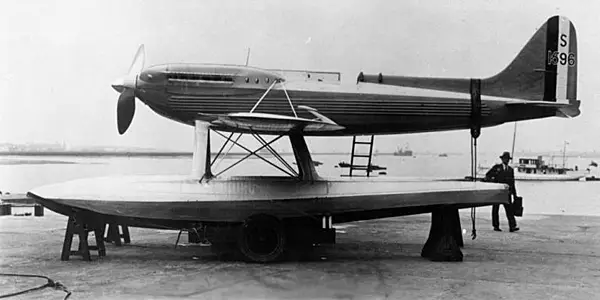
Seaplane Supermarine S.6B
To participate in these competitions, R. J. Mitchell developed a car Supermarine S.6B. It was a seaplane - a tiny monoplane on two floats, which showed fantastic speed results. Supermarine S.6B, which was piloted by Lieutenant George Stainforth, was powered by Rolls-royce merlin supercharged with a capacity of 1 hp. With. and represented one of the main technical achievements of the British aviation between the two world wars.
This aircraft not only won the 1931 Schneider Prize, setting an absolute speed record of 655,67 km/h, but two weeks later it became the fastest vehicle on earth.

Seaplane Supermarine S.6B
Note. The fuel tanks of the Supermarine S.6B were placed in floats, from where fuel was pumped through the struts into a small pressure tank located above and feeding the carburetor under the influence of differential pressure, which ensured the supply of fuel to the engine during turns.
The fixed pitch propeller provided optimal performance at 655 km/h but proved problematic at low takeoff and landing speeds, severely exacerbating the torque problem*.
To reduce the drag of the aircraft, Mitchell abandoned the water cooling radiator - instead, the wing had a double skin, inside of which the steam was cooled, and after cooling, the water flowed into special containers located in the fairings of the landing gear, from where it was pumped back to the engine. The pilot was in a narrow cockpit surrounded by an oil cooling system, and the cabin was hot and uncomfortable. In addition, the already limited visibility during the take-off run was difficult, as the floats churned up the water, splashing the pilot’s glasses with splashes...

The maintenance team brings the Supermarine S.6B ashore
Outstanding performance Supermarine S.6B allowed Mitchell to be recognized as a designer of high-performance machines, which served as a further impetus for development as a future fighter Supermarine Spitfire, and the engine Rolls-royce merlin. Neither R. J. Mitchell nor co. Supermarine did not continue to produce racing seaplanes for subsequent competitions, since work on developing a new fighter at the direction of the British government took priority.
The fact is that just 18 days after the triumph Supermarine S.6B At the Schneider Cup, the British Air Ministry issued the F7/30 specification, which called for a tender and required developers to create an all-metal land-based fighter, and sought innovative solutions aimed at significantly modernizing British fighters.
And accordingly, Mitchell’s next step after Supermarine S.6B was the development of a new aircraft that meets this specification, designated Type 224.

Supermarine Type 224 - an unsuccessful fighter model
And although Type 224 turned out to be that first pancake, which usually turns out to be lumpy, disappointed the selection committee of the British MoD, and was not chosen for mass production, but failure Type 224 did not discourage the designer, and his very next project led to the development of the legendary Spitfire.
Work on the Spitfire
If we rewind a little and return to Supermarine S.6B, then it would seem that the British Ministry of Defense should have been seriously interested in it, since in the version without floats Supermarine S.6B could have become a good fighter prototype, but nothing like that happened, but rather the opposite happened - absolutely no interest was shown in the aircraft, and the wheeled fighter project could have died on the vine. The Ministry of Defense did not allocate a single penny for the further development of the future vehicle!

Supermarine S.6B delivered to the launch site
Note. Despite the promise of British Prime Minister Ramsay MacDonald (Ramsay MacDonald) that government support would be provided to the winner of the Schneider Cup, official funding was withdrawn long before the Schneider Cup, less than two months after the Wall Street Crash of 1929.
The official reason for the refusal was that the previous two competitions had collected enough data on high-speed flight that further expenditure of public money was unjustified, and even the committee created by the Royal Aero Club, which was responsible for organizing the 1931 Cup, in which included representatives of the aviation industry, financed from private sources.

Italian pilots near a seaplane at the Schneider Cup
Private sources
A huge role in fate Supermarine S.6B, and subsequently the future Spitfire, and indeed R. J. Mitchell himself, was played by a socialite named Lucy Houston, who, after a conversation with the designer of the future car, decided to give him full support and allocated him 100 pounds sterling from her own pocket - a huge amount of money at that time - to further continue the development of his new single-engine seaplane Supermarine S.6B.

Lucy Houston - a socialite who financed the project of the future fighter
In the English world, this lady was a very curious and colorful figure; she was married three times to quite rich people, which allowed her to easily carry out such charitable actions and without whose money, of course, she could not Supermarine S.6B, or subsequently the Spitfire would not have been born.
Having received enough money from a socialite, Mitchell enthusiastically began working on a new car, and an engine appeared at the very right time - Rolls-royce merlin, which, when combined with a Mitchell-designed airframe, subsequently produced fantastic results.
Without Lady Houston's funding, R. J. Mitchell's design team would not have accumulated such experience in the production of high-speed aircraft that later became the Spitfire. Unfortunately, Lady Lucy never saw the Spitfire take to the skies - she died on December 29, 1936.

Lucy, Lady Houston, surrounded by RAF pilots, 1931. Mitchell is on the right. Photo: Royal Air Force Museum
Note. Lucy Houston offered then-Prime Minister Ramsay MacDonald £200 to strengthen British air power and, when she was refused, installed a six-foot-tall banner on her Liberty yacht with electric lights flashing the words "Down with the traitor MacDonald."
After the 1935 parliamentary elections, Stanley Baldwin became Prime Minister of Great Britain, and Lucy Houston wrote a letter to Hitler urging Nazi Germany to join Britain in completely crushing Soviet Russia. She also demanded that the new prime minister fight more actively against socialism and withdraw from the League of Nations!
Because of the threat of war, Lady Houston sent another check for £200 to the British Chancellor of the Exchequer Neville Chamberlain, the future Prime Minister, to purchase fighter aircraft for the defense of London. But the British military believed that bombers, not fighters, would save the country.
Without Houston's participation, there might never have been a fighter aircraft called the Spitfire, and Lady Lucy herself would never have earned such honorary titles as "Godmother of the Royal Air Force" and "The Woman Who Won the War." As early as 1958, on the centenary of the birth of Lucy Houston, Lord Tedder, Marshal of the Royal Air Force, publicly expressed regret that there was not enough a monument to Lucy Houston on the white cliffs of Dover (Kent).
Continuation of work on the fighter
So, thanks to the donation of this society lady, after the success Supermarine S.6B, R. J. Mitchell was able to continue working on the monoplane, gaining extensive experience in the production of high-speed aircraft, which ultimately helped him in the development of the legendary Spitfire.
After failure with Type 224 at the very beginning of 1934, Mitchell conceived a fundamentally different machine, which was supposed to incorporate a combination of high-speed and maneuverable characteristics, coupled with powerful weapons and ease of use.

Supermarine Type 224 - an unsuccessful fighter model
First of all, the plane conceived by Mitchell was supposed to be an interceptor capable of protecting the island from air raids by German aircraft - people still remembered how Zeppelins bombed British cities during the First World War, and Mitchell was well aware of what the new German planes could do to the island even greater disasters.
Initially, the fighter was designed for an engine Rolls-Royce Goshawk power 600 hp s., the same as was installed on Type 224. But due to its lack of power, it held back some of the innovative implementations of Mitchell's next-generation aircraft, which embodied the desire for greater aerodynamic perfection.
The situation was saved by the new twelve-cylinder engine from Rolls-Royce RV-12 (later named Merlin), demonstrating a power of 650 hp. With. at the ground and 790 l. With. at an altitude of more than three thousand meters. And at a company production meeting Supermarine Aviation Works a decision is made to tailor the fighter design to the engine Rolls-Royce RV-12.
The matter immediately got off the ground - the Ministry of Aviation immediately showed interest in such a promising project, and by the beginning of December 1934, an agreement was concluded with the company to finance the construction of the prototype. And by April of the following year, a full-size wooden demonstration model of the future machine was ready.

Twelve-cylinder engine from Rolls-Royce RV-12, later named Merlin
It should be recalled here that in 1934 R. J. Mitchell made a trip to Germany and saw the rapid rearmament of the Luftwaffe, and also visited factories that were equipped with advanced modern designs, far superior to the British, which prompted him to quickly begin work on the fighter that would later will be named Spitfire.
Note. An engine was chosen to drive the new fighter Rolls-royce merlin – powerful four-stroke v-shaped 12-cylinder engine with power from 650 to 1 hp. With. (taking into account further modernization), depending on the specific option. This choice proved decisive in the success of the aircraft, since the engine Rolls-royce merlin provided the speed and performance necessary for air combat.
But, as is always the case, this engine also had one serious drawback compared to German engines, which were equipped with a fuel injection system that ensures precise delivery of fuel into the combustion chamber. The Rolls-Royce Merlin still used a carburetor, the only advantage of which was that it was much simpler, cheaper and required much fewer components, which is why it turned off during a dive and a short flight in an inverted position - to it so-called “negative overload forces”, and fuel stopped flowing into the carburetor.
Thus, a German pilot with a Spitfire on his tail could simply do a “negative G”, going into a dive, and the Spitfire, fearing a decrease in pressure in front of the carburetor, would lag behind the pursued car, preventing the engine from cutting out, it was just a matter of a second or two, but it was precisely this second that the German pilot needed to get behind the Spitfire or break away from its pursuit.
But Spitfire pilots figured out a way to get around this carburetor problem and began to perform a half-turn before diving, which meant that the force of gravity acted in the opposite direction and the carburetor never remained “dry”.
However, cunning maneuvers by the pilots were not a solution, and by 1941 this carburetor problem was solved by one of the company’s employees, engineer Beatrice Schilling, who proposed drilling a hole in one of the carburetor walls with the diameter of a penny coin, which made it possible to avoid “drying out” of the carburetors . This simple and temporary design solution solved the problem of reverse overload until the advent of true negative overload carburetors in 1943. This invention was called “Miss Shilling’s Hole”, and she herself, because of the diameter of the hole she proposed, was called “Money Penny”.

In the first row on the right is engineer Beatrice Schilling, who proposed drilling a hole in one of the walls of the carburetor with the diameter of a penny coin, which made it possible to avoid the “drying out” of the carburetors. Design team
This engine was used not only on Spitfires, but also on heavy four-engine Lancaster bombers (Avro Lancaster), Mosquito fighter-bombers (De Havilland Mosquito), Hurricane fighters (Hawker Hurricane) and on American Mustang fighters (North American P-51 Mustang).
So the engine Rolls-royce merlin became for the British as much a symbol of the Second World War as the Spitfire itself.

Pre-war photograph taken outside the building where Supermarine's administrative, commercial, design and experimental departments were based
So, by mid-1935, the work of Mitchell's team engineers led to the creation of the final version of the Spitfire, a fighter that had a speed of almost 64 km/h faster than its direct competitor, the Hurricane. Ingenious architecture born in the depths of the company Supermarine The Spitfire was the result of the vision and engineering prowess of one man: Reginald Joseph Mitchell.
Something about the design
The design of the Spitfire was innovative for its time, and although the rival Hurricane also had a superior design, the Spitfire was still much more innovative and radical in its design.
Key features of the newly born fighter included a sleek elliptical wing, designed by Canadian engineer Beverly Shenstone, with a very thin airfoil providing exceptional maneuverability and speed, especially at high altitudes, and its all-metal, stressed-skin aluminum construction* and retractable landing gear were advanced technologies that set it apart from its contemporaries.

The combination of a large wing area with a thin elliptical shape and a large fairing filling the low-pressure zone where the upper part of the wing meets the fuselage contributed to better turning, which was an unpleasant shock to the Luftwaffe pilots who first encountered the Spitfire...
If you look closely at the wing, it resembles the wing of the German Heinkel - one of the light sports German aircraft, and evil tongues whispered that the developer of the wing - Beverly Shenstone - who himself worked for some time at the Heinkel Flugzeugwerke company, borrowed some design ideas there - all-metal, cantilever, two-spar and elliptical wing.
The innovative solutions of the developers also include removable wing tips, which were produced in three types - classic round, shortened and pointed, using which it was possible to change the wing area and its properties. The main purpose of such winglets was to reduce the inductive drag of the wing, save fuel and improve performance when climbing and reducing the take-off run.

The finished wing with landing gear and wheel sits in a felt-covered support awaiting delivery to the final assembly line.
The power set of the wing included two spars and twenty-one ribs, and the duralumin tension* The wing skin was load-bearing and was attached to the frame with hidden rivets. The struts of the tricycle landing gear, retractable by an integrated hydraulic system, were attached to the reinforced wing spar in the fuselage area, and two cooling radiators were placed under the wings, which were aerodynamically covered by a common air fairing.

Fuel tank on the left and a set of frames for the lower part of the fuselage on the right
All the wing mechanization was suspended from the rear spar - all-metal ailerons and two-section flaps, also all-metal. The drive of the entire mechanical piping of the wing was pneumatic, and inside it, between the ribs, there were weapon compartments and ammunition.

Left: A worker polishes a propeller blade. Right: Female workers install electrical wiring. This activity is divided into successive stages
It should be noted here that the plane turned out to be very beautiful, so beautiful that the British aviation historian Ray Johnson in his articles talked about the sexuality of this plane, comparing the smooth contours of the fighter with the lines of a woman’s body. Here’s how pilot Diana Barnato Walker, who flew Spitfires from the factory to military airfields, gives the aircraft a description:

Right: Generator purchased for Merlin engine. Left: hydraulic hoses
There is a funny story going around among the creators - when someone told Mitchell as a compliment that he had created a fantastically beautiful plane with an amazingly beautiful wing, Mitchell replied:
Note. The Spitfire was the first British fighter to have hidden rivets, that is, they were riveted flush with the skin, but during the war, due to time constraints, they produced a batch of cars with ordinary, mushroom-shaped rivets, and these cars immediately lost speed about 40–45 km/h. And despite the fact that finishing a car with hidden rivets was difficult, expensive and time-consuming, manufacturers still stopped making such mushroom-shaped “warty” Spitfires and returned to the original technology.

Oxygen valve (left) and manual windshield de-icer pump (right)
First flight
By the fall of 1935, the idea contained in the idea began to be embodied in metal. Some changes to the design were made during the construction of the prototypes - in order to improve visibility of the rear hemisphere, the cockpit glazing area was slightly increased, and instead of one exhaust manifold located under the fuselage, separate pipes were installed. In February 1936, construction of the machine was completed, and on March 5, the elegant silver machine, under the control of Captain Joseph Summers, made its first flight, marking the beginning of a legendary chapter in the history of aviation.

The prototype of the Spitfire, which the company Supermarine designated by the index K5054 and Captain Joseph Summers (1904–1954), the chief test pilot, who before a flight always liked to urinate on the rear wheel of the plane for good luck. Landing just 8 minutes later, Summers was supposed to have said, "Don't change anything!"
This iconic British fighter, still under the designation K5054, took off for the first time at Eastleigh airfield (Eastleigh), Hampshire, which is now an airport. The factory was also located in Eastleigh Supermarine Aviation Works, where the Spitfire was designed and built. The Spitfire prototype that took to the skies had a maximum speed of 550 km/h, which was even higher than the requirements of the Ministry of Aviation, thereby the new aircraft exceeded all expectations and was almost 65 km/h faster than its direct competitor, the Hurricane!

The prototype of the Spitfire, which Supermarine designated with the index K5054
R. J. Mitchell, the Spitfire's designer, paid close attention to the safety and reliability of the pilot - the aircraft's retractable landing gear was still a novelty at that time, and many early accidents were caused by pilots forgetting to lower the wheels before landing.

Mitchell sits on the running board of his car, surrounded by other employees. Supermarine. First from left is test pilot Joseph Summers. Photo: Royal Air Force Museum
It is probably unnecessary to say that the first flight was a resounding success - the fighter demonstrated excellent controllability and performance characteristics, immediately revealing its potential as a fighter of the highest level, thereby laying the foundation for further development.

After the successful flight of the first Spitfire prototype, K5054, in March 1936, test pilot Joseph Summers declared: “I don’t want anything touched.”
weaponry
In May 1935, the Ministry of Aviation approved the final version of the armament of the new fighter - instead of the originally planned four machine guns and four twenty-kilogram bombs, the new requirement required the installation of 8 short-barreled Vickers K wing machine guns of 7,69 mm rifle caliber (or 7,71. 100 at different times) with XNUMX rounds of ammunition per barrel, but these machine guns had very weak firepower.
And gradually the Vickers began to be displaced from British military aircraft, and in their place came the 12,7-mm American Browning M2 with belt feed, which turned out to be preferable due to its higher rate of fire, larger caliber and convenient aerodynamic profile. And by 2, after the Battle of Britain, the Vickers had already been completely forced out of the Royal Air Force fighter squadrons.

Vickers K machine gun, rifle caliber
Note. It should be noted here that in order to install various modifications of weapons, it was necessary to modify the design of the wing itself, therefore, depending on the installed weapons, the aircraft had different wings, the type of which usually indicated the armament of the fighter that a particular aircraft could carry.
So, for example, “wing A” (A-wing) had eight 7,71 mm machine guns, “wing B” (B-wing) had four 7,7 mm machine guns and two 20 mm cannons, and the “wing C (C-wing or Universal Wing) could be equipped with either four 20-mm cannons, or two 20-mm cannons and four 7,71-mm machine guns, while the “E-wing” (E-wing) had two 20-mm mm Hispano cannons and two 12,7 mm Browning M2 machine guns.

12,7 mm Browning M2 aircraft machine gun (.50 AN M2)
The eight Vickers K machine guns fitted to the original version of the fighter certainly gave it great firepower, but when the Germans began adding armor to their bombers, it was discovered that the power of these machine guns was no longer enough, and the developers began to experiment with the use of A 20-mm Hispano cannon, which was already guaranteed to hit air targets. But the installation of the Hispano cannon, in addition to increasing firepower, also created many problems, one of which was the size of the cannon itself.
Another early problem with this gun was its tendency to jam when overloaded during combat, and if one gun jammed, the recoil from the other was enough to seriously throw the Spitfire off course.
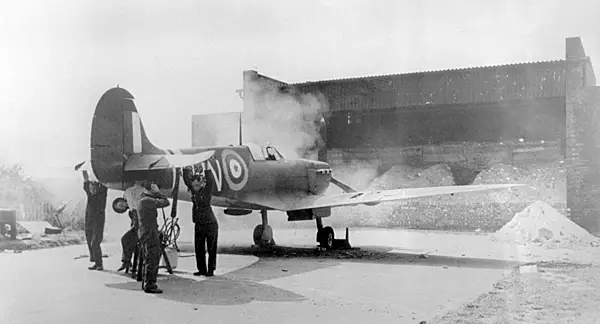
Spitfire weapon testing at Biggin Hill airfield
The same cannot be said about flying at high altitudes, when the guns began to freeze at high altitudes, which required innovative solutions such as pumping hot air from the engine to the guns.

Gunsmiths of the Polish 315th Squadron replace the 20 mm Hispano cannon. This Spitfire (Spitfire Mk V) originally carried a drum gun, which was later replaced by a belt-fed version
This new weapon was so unreliable that the squadron testing it asked for their old Spitfires to be returned to them! But by August 1940, a more reliable system for attaching guns and supplying ammunition to them was introduced into the design, and the problem of jamming was successfully solved.

20mm Hispano drum-fed gun
Armored protection
During the First World War and after its end, some design bureaus developed armored "attack aircraft" with the layout of a conventional fighter, but with much heavier armor. However, when planning a future war, military theorists did not assume that these aircraft would subsequently become fully effective fighters!

Fighter armor locations
For example, Hurricanes and Spitfires entered production without any armor plates. Their need was quickly recognized after the outbreak of World War II, and their modifications were given a very high priority. Most of the Royal Air Force (RAF) fighters that flew in the Battle of France, which was the majority of the force, did not yet have armor installed, but all fighters had already been modified before the Battle of Britain began. For the Spitfire this included 33kg of armor plate and armored windshield glass bolted to the outside.

Left: The armor plate that fits into the cockpit behind the pilot's head. Right: Cabin with new internal bulletproof windshield
Note. One of the first specialized single-seat fighters with armor already installed was the Polikarpov I-16 Type 4, which flew in 1934 and entered mass production at the Moscow and Nizhny Novgorod plants in 1935, where a small 8 mm thick headrest armor plate was installed. The windshield remained a simple sheet of curved plexiglass. However, the small Soviet fighter, the most advanced single-seat fighter of its time, was again far ahead of its time.
Aviation armor for installation on aircraft had been under consideration in the USSR since around 1930, when the country developed suitable nickel-molybdenum steel alloys. Moreover, most countries did not install armor on their fighters until almost 1940...
As mentioned above, the Spitfires of the very first releases had no armor protection at all, but with the beginning of the war the need for armor on a fighter aircraft became clear very, very quickly, but the installation of armor was limited by strict weight restrictions.
The developers only managed to install an armored partition behind the pilot’s seat that could withstand hits from rifle-caliber bullets, and increase the frontal armored glass of the cockpit canopy to a thickness of 38 mm, covering it with transparent laminated panels. In addition, the fuel tanks were covered on top with 3-mm light alloy plates, the plates of which could withstand hits from rifle-caliber bullets when fired from sharp angles.
Emergency stock
On board the fighter there was a supply of water, an emergency ration in a sealed tin can, and an inflatable boat with a carbon dioxide cylinder - in case of an emergency landing.
Spitfire's first battle

The first battle in which Spitfires took part took place on October 16, 1939. On this day, aircraft of the 602nd (city of Glasgow) and 603rd (city of Edinburgh) divisions entered into battle with German Junkers bombers (Ju-88), which carried out air strikes on the ships of the Royal fleet over the Firth of Forth (Firth of Forth) off the eastern coast of Scotland. This was the first air attack on Britain since the end of the First World War. As a result of this battle, two German planes were shot down.

Left: An aircraft spotter watches the skies over London, 1940. Right: receiving station towers
The Spitfires' high speed meant that they were able to intercept and destroy two Junkers 88s and seriously damage another. Thus, the power and lethal capabilities of the Spitfire have now been proven in practice!

In the Battle of Britain
In the Battle of Britain
In the early summer of 1940, the situation for Britain was critical - it remained the last European power opposing Hitler, and Hitler was seriously considering the possibility of Operation Sea Lion, which included a large landing on the island, and the decisive moment for the Spitfire had arrived!

Battle of Britain. The pilots rush to their cars
And in order for the plan to succeed, Hitler ordered the Luftwaffe to destroy the Royal Air Force. With 1 fighters and 030 bombers, the Germans launched several simultaneous raids on August 1, 320. The British had 13 fighters - Hurricanes and Spitfires - and the most powerful radar system in Europe. And even despite the numerical
superiority, the Germans clashed harshly with fighter pilots, who offered them heroic resistance.

A Messerschmitt shot down by a British Spitfire over London is displayed in front of the Houses of Parliament, 1940.
Described by Prime Minister Winston Churchill as “the few,” these pilots had two key weapons with which they fought off German fighters and bombers. One of these was the Hurricane, which inflicted more than fifty percent of the Luftwaffe's losses. The second was the hero of this article, the iconic, lightning-fast and highly capable interceptor aircraft known as the Spitfire (Supermarine Spitfire Mk I).

Maintenance (left) and gyroscopic sight (right)
Note. The Hurricane fighter was known for its ruggedness and reliability, and proved very effective in combat against enemy bombers. It was the Hurricane pilots who shot down the most aircraft over the skies of Britain. Indeed, 55% of German aircraft were shot down by Hurricanes, 42% by Spitfires, but there were twice as many Hurricanes as Spitfires!

A British fighter squadron near a Spitfire. This squadron destroyed 73 enemy aircraft and damaged another 38
The rigid controls and narrow chassis of the German Messerschmitt fighter (Messershmitt BF 109) were a disadvantage compared to the Spitfire, whose sleek lines and two-stage supercharged Merlin engine made it easier for British pilots to fly at high altitudes.
Ultimately, the Spitfire had better combat capability and the Germans lost more aircraft, making it a hero of the Battle of Britain and an icon of British air combat ever since. Here are some of the key ways in which Spitfires contributed to the Battle of Britain:
1. Air superiority. The Spitfire was a high-performance fighter aircraft known for its speed, maneuverability and firepower. It was capable of at least on par or even with an advantage in certain conditions against the best German fighters, especially the Messerschmitt, earning air superiority.
2. Improved features. The Spitfire's exceptional maneuverability and tight turning radius made it highly effective in dogfights. British pilots were able to engage in close combat and usually outperform their opponents, gaining an advantage in dogfights.
3. Versatility. This fighter was versatile and capable of performing a variety of combat missions - it could intercept enemy fighters and bombers, accompany reconnaissance aircraft and, if necessary, even conduct ground attacks. Such high adaptability allowed him to respond to the constantly changing situation on the battlefield.
4. Bomber escort. Spitfires, along with Hurricanes, provided vital escort protection for British bombers such as the Avro Lancaster and Vickers Wellington from attack by German fighters.
5. Interception at heights. The design of the Spitfire gave it the ability to operate effectively at high altitudes, allowing it to intercept German bombers flying at medium and high altitudes.
6. Psychological impact. The Spitfire, with its elegant design and distinctive elliptical wings, became a symbol of British resistance and determination. His presence in the skies raised morale both among the British population and among the Royal Air Force pilots themselves, and conversely, struck fear into the hearts of the enemies who saw him.
7. Defense of British cities. By thwarting Göring's attempts to gain air superiority, the Spitfires helped protect British cities from devastating aerial bombardment, and this was an important aspect of the battle as the Luftwaffe's failure to establish air superiority over Britain led to the abandonment of Operation Sea Lion, the planned invasion of Britain.
8. Non-stop production. The British aviation industry was able to increase production of Spitfire fighters during the Battle of Britain, providing the front with a steady supply of aircraft, allowing the Royal Air Force to replace inevitable losses and thus maintain a powerful fighter force throughout the campaign. The Spitfire's well-thought-out design also made it relatively easy to maintain and repair, reducing downtime and ensuring that the aircraft could quickly return to combat duty after sustaining damage.

Spitfire pilots
In the end, the Spitfire, along with the Hurricane and the valiant efforts of the British pilots, played a hugely significant role in the aerial victory for Britain, and their tenacity and skill completely denied the Luftwaffe air superiority, marking a turning point in the war and testament to an enduring legacy." Spitfires" as one of the most iconic fighter aircraft in history.

Reloading machine guns on a Spitfire before a combat takeoff
Note. Since the Battle of Britain, the Spitfire has undergone many changes, culminating in its final iteration (the Supermarine Spitfire Mk24) in 1947, and its revolutionary design and then-advanced performance have influenced many generations of fighter aircraft to follow.
For example, Geoffrey Quill, Supermarine's chief test pilot, joined the Royal Air Force to more fully study the fighter in combat at the height of the Battle of Britain and flew for several weeks with No. 65 Squadron RAF in order to experience for yourself all the problems that the Spitfire pilots spoke about when using the fighter in combat.
Over the course of nineteen days, Quill recommended several major improvements to the Spitfires, including redesigning the canopy to improve visibility and replacing the existing canvas ailerons, which had a tendency to swell during dives, with metal ones. And these recommendations of his were quickly included in the design, to the delight of the pilots. By the way, during tests of the Spitfire, he personally shot down two Messerschmitt Bf 109s!

Jeffrey Kindersley Quill, Chief Test Pilot, Supermarine
Spitfires and radar


Women in the Royal Air Force - WRAF (Women's Royal Air Force)
By the end of 1936, a closely linked radar early warning system known as Chain home (CH), and since 1939 a new system has appeared - Chain Home Low (CHL), capable of detecting low-flying targets.
Combined with observation stations (men on the coast with binoculars), this provided British air defense forces with an important method of early warning of air attack. This radar could detect approaching enemy aircraft at a distance of 129 km and played a decisive role in the Battle of Britain.

Towers for transmitting and receiving antennas of the Chain Home Low tracking station
The radar was a vital part of Air Marshal Hugh Dowding's system - Britain's highly effective and sophisticated air defense network, which enabled RAF Fighter Command toRAF) to react instantly to bombers approaching the island, which gave a few extra precious minutes to the Spitfire pilots, who could already intercept the Luftwaffe before they reached their targets, thereby using precious pilot and aircraft resources to maximum efficiency.
Throughout the war and during the Battle of Britain, many of those manning radar stations at RAF stations were women - members of the Women's Royal Air Force - WRAF (Women's Royal Air Force).

Interior of the reception area at the CHL AMES Type 2 station
Note. Although radar was an important tool for Britain's victory, the technology was actually developed in Germany, but the Luftwaffe did not realize the huge role radar played in British defense. German planes attacked ships, airfields and cities, but their goal was never to destroy radar stations. An exception is that only one radar station on the Isle of Wight received serious damage. And this important oversight by the German command allowed British air defenses to stay one step ahead during the Battle of Britain. And the radar stations dotted all over the coast of Britain were one of the reasons that Spitfire flights were always a huge success!

Left: Radar operator Denise Miley "flying" the aircraft on a CRT (Cathode Ray Tube). Right: Interior of the station reception area
Deployment
Although the Spitfire is usually associated with the Battle of Britain and the War in Europe, it saw active service in other theaters around the world, such as:
1. Spitfires were widely used in the Mediterranean, where they saw action over North Africa, Italy and the Mediterranean.
2. Spitfires were also used in North Africa to counter Axis forces in campaigns such as Operation Torch (Operation Torch – landing of Allied forces in French North Africa on November 8, 1942) and the Tunisian campaign (battles in North Africa 1942–1943).
3. Spitfires were operated by several Commonwealth air forces in the Asia-Pacific theater - the Royal Australian Air Force (RAAF) and Royal New Zealand Air Force (RNZAF) and India. They were used for a variety of purposes, including air defense and ground attack.
4. Spitfires served with the Royal Air Force in Burma, where they were an important component of the Burma campaign against Japanese forces. The arrival of the Spitfires helped prevent Japanese advances into China and India. By January 1944, six Spitfire squadrons had played a major role in achieving air superiority over western Burma.
5. The Chinese Kuomintang Air Force received Spitfires as part of Lend-Lease agreements with the Allies, and these aircraft contributed to China's war effort against the Japanese occupation forces.
6. 1 Spitfires took part on the Soviet-German front.

British Spitfire pilots in Burma
Soviet-German front
Deliveries of Spitfire fighters (Spitfire Mk. IX) to our country began in January 1943 - the first shipments arrived through Iran, and then through our northern ports. At first these were old aircraft that had undergone repairs and modernization, and later new aircraft began to arrive, straight from the factories, and deliveries ended after the end of the war in Europe - in the summer of 1945. Only two of them are high-rise.

Spitfire at a Soviet airfield
The Spitfire, with its powerful and high-altitude engine, had a significantly greater service ceiling than all domestic serial fighters - it confidently climbed to an altitude of 12 meters, which was 500 meters more than the Yak-2U (improved) and 450 meters - than the La-9. The Spitfires were superior to the above-mentioned Yakovlevs and Lavochkins both in their rate of climb and in their armament, and the special equipment installed on the fighter made it stand out for the better.

Soviet pilots
But at low and medium altitudes, where battles usually took place on the Soviet-German front, the Spitfire was seriously inferior to domestic fighters - for example, in ground speed they lost to the La-7 by about as much as 100 km/h, so the use of these fighters at the front the aviation command was considered inappropriate, and most of them were sent to air defense regiments.

Soviet officers near a Spitfire fighter
The first batches of fighters delivered, as mentioned above, included used aircraft that had already served in the Royal Air Force; moreover, it was discovered that the Merlin engine installed on them was very sensitive to the dusty airfields of the Soviet-German front, and All these problems were further aggravated by a serious shortage of spare parts...

Construction of the engineering and technical staff of the 26th Guards IAP in 1945. In the background are Spitfire fighters (Mk. IX) with Guard insignia
The first Spitfires were adopted by the 28th Independent Reconnaissance Squadron of the Northern Fleet, where they successfully photographed the German heavy cruisers Scharnhorst and Admiral von Scheer, among other warships, in the Norwegian fjord Altenfjord.
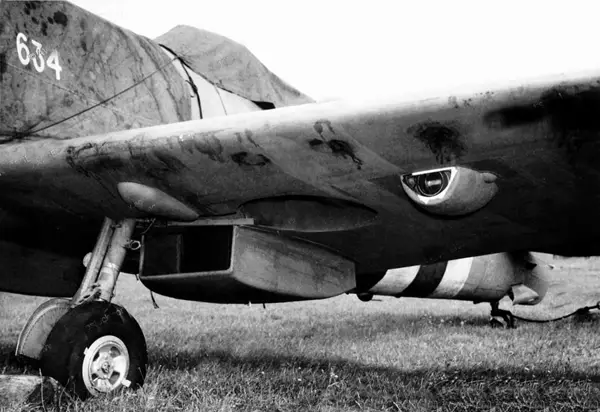
Spitfire for aerial reconnaissance. The F24 aerial camera with an 8-inch lens, installed in a blister under the wing of the aircraft, is clearly visible
Spitfires also took part in the air battles for Kuban, where they were used mainly to support ground forces behind the front line, and in the Black Sea Fleet they provided air cover for fleet bases.

"Spitfire" (Spitfire Mk. Vb) with a Soviet radio direction finder RPK-10M. The round antenna above the cockpit fairing is clearly visible
Note. You will smile, but Soviet pilots first tested the Spitfire in March 1941 in the most unexpected place - in Germany, when the Soviet delegation arrived there, and the Germans showed the captured Spitfire (Spitfire Mk. Ia) to the Soviet representatives and even allowed the test pilot S.P. Suprun (1907–1941) to test it. S.P. Suprun took off on it and was clearly impressed - he liked its excellent stability and easy handling, and the only shortcomings he noted were the small fuel supply and the lack of cannons and large-caliber machine guns.
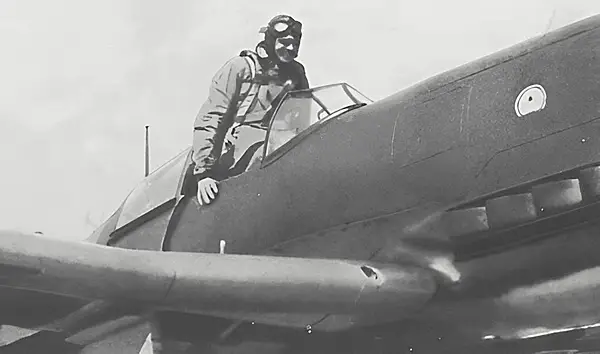
Stepan Pavlovich Suprun - test pilot and the first Soviet pilot to fly the Spitfire
Sometimes already heavily used engines often failed, and fighters were repeatedly forced to make forced landings, and even then, only one Spitfire was written off for non-combat reasons...
Curiosities. Spare parts for this fighter were a constant problem, but aviation specialists were very inventive - for example, Lieutenant Engineer Manochkin, head of the aircraft repair base, installed wheels from the MiG-3 fighter on the Spitfire.
Sometimes, due to a lack of spare parts, aviation technicians, as a temporary measure, placed washers cut from empty cans on the piston rings in order to somehow keep the fighters in working order. Spitfires on the Soviet-German front sometimes even suffered from mistaken identity, as they were sometimes mistaken for Messerschmitts from certain angles (Messershmitt BF 109).
Spitfires on Soviet ships
The Soviet command had plans to use Spitfires as catapult fighters to protect large warships, as was done in the British Navy, and by the end of 1943, design work began at the Leningrad plant to install a catapult on a warship, and already the following year Work began on modifying the Black Sea Fleet cruiser Molotov, and by the fall of 1944, ten Spitfires were transferred to the specially formed 24th Naval Aviation Squadron, based at the Alma-Tomak airfield (Crimea).

"Spitfire" mounted on the catapult of the cruiser "Molotov"
During the Great Patriotic War, Spitfire launches were not carried out from a catapult, but in 1946, three successful launches from a ship’s deck followed by landing at the Gelendzhik airfield from the Molotov cruiser were nevertheless carried out and completed without incident.
For test flights from a catapult, the pilots received a Swiss Longin wristwatch as a reward (Longines ) from the commander of the Black Sea Fleet Air Force.
"Seafire" - marine version
"Seafire" (Supermarine Seafire) was an urgent modification of the Spitfire, intended to create a carrier-based fighter, where the chassis was slightly improved, which from the very beginning of the Spitfire’s creation was not designed for the harsh conditions of landing on the deck of an aircraft carrier. New naval aircraft (Seafire Mk IB) was a modification of the ground-based Spitfire (Spitfire Mk Vb), in which the landing gear was strengthened, a retractable brake hook was added (hook*) and the fuselage was significantly strengthened.

Seafire with folded wings. The aerofinisher is clearly visible from behind (hook)
In addition, the Seafire received many small parts necessary to adapt the marine Seafire to the special operating conditions of the fleet, including anti-icing devices for radio antennas, an air intake damper (only on Spitfires in tropical zones) and installation for signal signals. cartridges.
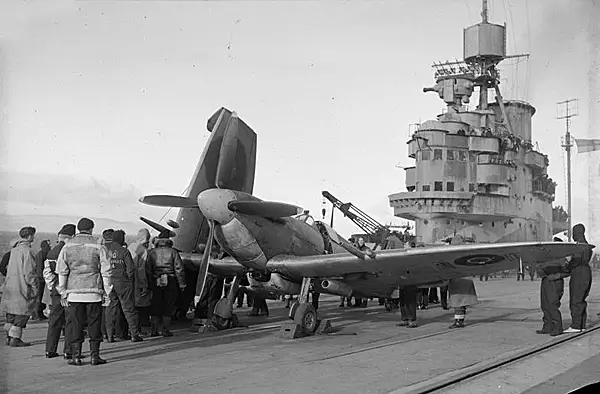
Emergency landing of Seafire on the deck of an aircraft carrier
The main obstacle to converting the future Seafire from the Spitfire was the fact that during the development of the Spitfire it was never intended to be used aboard an aircraft carrier. In addition, the type's two main problems were poor forward visibility and the inability to carry large quantities of fuel on board.
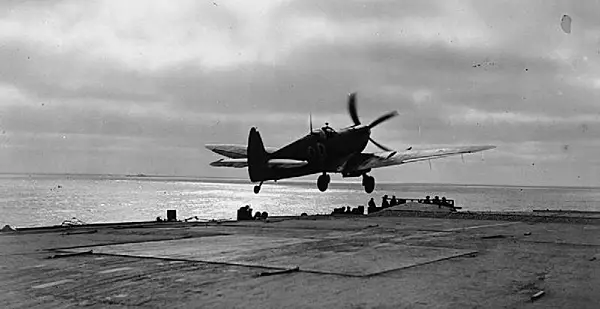
Seafire takes off from the deck of the aircraft carrier HMS Furious
All Seafires (like the Spitfires) had a disadvantage similar to the German one Messerschmitt BF109 – narrow chassis track (albeit wider than that of the Messerschmitt), which was the cause of many accidents associated with loss of lateral stability when moving along the deck.
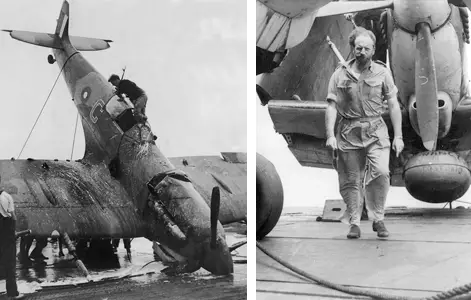
Left: Another bad landing. Right: aircraft technician
But during the fighter's operational life, it was discovered that due to the more complex approach techniques used to land on the deck of an aircraft carrier, approach techniques were difficult, visibility (due to the cockpit layout) was limited at best, and landing gear destruction was common. In addition, the arresting hooks had a tendency to overshoot and bounce back into the fuselage with an inevitable subsequent collision with the deck parking lot or ship barrier.
Therefore, as a fleet defense interceptor, the Seafires were excellent vehicles, but their fragility was their Achilles heel, causing most of the vehicles to be lost as a result of chassis failures during hard landings, rather than due to enemy action. By June 1945, auxiliary fuel tanks were added to the Seafire, which increased its combat range by 50 percent and allowed it to take part in serious offensive operations.

Seafires had folding wings for placement on aircraft carriers
A total of 2 Seafires were produced, both converted from Spitfires and assembled to accommodate changes to the design.
Note. Back in 1940, the creators of the Spitfire proposed a naval version of the fighter with a brake hook and folding wings, and the Navy requested permission from the Ministry of Aviation to build 50 Spitfire aircraft with a folding wing and a brake hook, but for unknown reasons, Winston Churchill, who was at that time moment the First Lord of the Admiralty, canceled this request. Perhaps fearing a German invasion of the island, it was essential to continue production of land-based Spitfires in order for the Royal Air Force (RAF) to defend the island.
This naval fighter had manually folding wings and a more powerful (2 hp) engine for greater hangar space. Rolls-Royce Griffon with a single-stage supercharger.

During the war, the Seafire was used to provide air cover during the Allied invasion of Sicily and the subsequent invasion of mainland Italy. She took part in the D-Day landings, providing air support for the troops as they landed on the beaches of Normandy, and in the later stages of the Second World War Seafire joined the British Pacific Fleet, where she valiantly repelled kamikaze attacks by the Japanese. pilots.
Already during the Korean War, the 800th Naval Aviation Squadron used Seafires operating from a light aircraft carrier HMS Triumph. Other users of the type included the French Navy and the Royal Canadian Navy.

Seafires on the deck of the aircraft carrier HMS_Triumph during the Korean War. 1950
Winemaking
Full-scale production of Spitfires began at the company's own plant Supermarine in Woolston, near Southampton, but the order could not be completed within the promised 15 months - Supermarine was a small company, moreover, fearing German bombing, the company adopted a plan to disperse individual workshops and factories.

Left: Prime Minister Winston Churchill watches a woman riveting a fuselage. Right: Women sort through ammunition destined for Supermarine Spitfires
Even before the German bombing in September 1940 and after the destruction of the Woolston and Itchen factories, the company Supermarine began evacuating production facilities to other areas so that production could continue - sometimes even requiring the support of the Minister for Aircraft Manufacturing, Lord Beaverbrook.

Left: The Merlins were tested in separate chambers, each equipped with a lift and an adjustable platform lift for engine installation and removal. Right: Rolls-Royce Merlin engines being assembled in Derby
Typically, the relocated workshops were located in and around Southampton, as well as the other manufacturing clusters of Winchester, Salisbury, Trowbridge, Newbury and Reading. And the main assembly plant was located in Castle Bromwich (bromwich castle), in the Birmingham area, which eventually produced more than half of all Spitfires produced and had its own network of subcontracting suppliers of over 300 companies.

Women's Voluntary Service - Women from Wickham, Hampshire, sort the different types of rivets needed to make the Spitfire.
Since the start of the war, there have been literally hundreds of subcontractors, usually small companies, producing everything from tiny parts to large sections of the aircraft, such as the tail section or the leading edge of a wing. In many cases, multiple companies supplied the same parts to meet demand as quickly as possible or simply to avoid becoming overly dependent on a single source.

Spitfire fighters under construction at Castle Bromwich
Post-war use
The era of the piston-engined monoplane fighter lasted from approximately 1935 to 1950, and the Spitfire was unique in that it was the only aircraft to span this entire period and remained the best until the very end, further highlighting the true talent of its creator - R. J. Mitchell. But the advent of jet fighters (Messerschmitt Me. 262) stopped the further development of piston aircraft and showed engineers the way to the future - after the end of the war, designers everywhere turned to the production of fighter aircraft with jet engines, and therefore the post-war service life of the Spitfires was short.
After World War II, Spitfires continued to serve in various air forces around the world, including Belgium, France, Greece, Norway and the Netherlands. Many of these countries continued to operate the "remnants" of the Spitfires in anticipation of the transition to newer aircraft with jet engines.
They participated in the Greek Civil War (1946–1949), in the Arab-Israeli War of 1948, where the Israeli Air Force (IAF) they played an important role in providing air superiority over the region, and in the later conflict of 1956 (the "Suez Crisis"), it was flown by both the Israelis and the Egyptians. He also saw action in Korea in the early 1950s, and his popularity continued to remain high until the 1960s.

Israeli Supermarine Spitfire in the 1948 Arab-Israeli War
Value
Supermarine SpitfireBorn of a dream and refined over years of development, the aircraft has etched its name into the annals of global aviation history, with its remarkable design, combat prowess and enduring heritage making it a symbol of innovation and courage. Reflecting on the history of the Spitfire today brings to mind not only its pivotal role in World War II, but also the indomitable spirit of all those who designed, built and flew this legendary aircraft.

The Spitfire could be loaded with two 250 lb bombs on the wings and one 500 lb bomb under the fuselage
Not only was the Spitfire an effective fighter, but it also had a significant impact on British morale during World War II - sleek and elegant design with a powerful engine Rolls-Royce made it a symbol of British technological prowess and military might, and the Spitfire itself became a symbol of British military might and a source of national pride.

Spitfire pilots in Burma. Although the Spitfire is usually associated with the Battle of Britain, it was also used in British theaters around the world during World War II
The Spitfire's iconic status continued to grow after the war, when it became an attribute of British resilience and determination during the darkest and most unpredictable days of the conflict, and pilots and historians continue to celebrate its legendary status to this day.

Fighters in Burma
Concluding the description of this legendary fighter, it is worth noting the special attitude of the British towards fighter pilots, pilots who saved the islands from raids by German Junkers and Heinkels - for them they were real demigods.

This is how the Spitfires sometimes returned from battle. But they returned...
For example, the British writer and World War II pilot Roald Dahl (Roald Dahl) in one of his stories recalls how, after being wounded and demobilized, he returned home, and one evening several drunken and adventure-seeking soldiers approached him on the street. At first they wanted to beat the officer, but then they noticed he was wearing a flying uniform and immediately left him alone - even for hooligans, the pilot was an inviolable person.

Spitfire repair in the field
Heritage
The Spitfire remains one of the most famous fighter aircraft in aviation history, and its legacy continues to this day.
Many Spitfires survived the war and can be seen today in museums and air shows around the world. The Spitfire has also inspired numerous films, books and works of art, and its iconic design has been replicated in countless other aircraft - it will always be remembered as one of the most iconic aircraft in history and as a testament to the ingenuity and determination of those who designed, built and operated it.

To increase the flight range, additional fuel tanks were attached to the Spitfire
In the post-war era, the Spitfire acquired iconic status, largely due to its decisive role in the Battle of Britain, and surely no other aircraft model graced children's bedrooms in such numbers. The Spitfire, with its speed and graceful lines, remains the shining star of air shows around the world, with approximately 50 examples still flying. This fighter is on permanent display in many museums around the world, most notably the Imperial War Museum and the Science Museum in London, the city it did so much to protect.

Installation of a camera in the Spitfire fuselage for photographic reconnaissance
The Spitfire remains a popular aircraft among aviation enthusiasts to this day, and many organizations and individuals are dedicated to the preservation and restoration of these historic aircraft.
Information
* Adolph Galland (Adolf Galland, 1912–1996). By the end of World War II, Lieutenant General of Aviation, Luftwaffe ace pilot and one of its organizers. He comes from a family of descendants of French Huguenots.
During the war (Western Front) he flew more than 700 combat missions, of which he was shot down four times. He was responsible for 104 enemy aircraft shot down, including seven victories in the Messerschmitt Me jet fighter. 262. Constantly clashed with Goering. Author of the post-war memoirs “The First and the Last. German fighters on the Western Front 1941–1945."
* Reginald Joseph Mitchell (Reginald Joseph Mitchell, 1895–1937). It should be remembered that Mitchell was diagnosed with cancer in 1933 and suffered severe pain until his death on June 11, 1937.
* Supermarine Aviation Works. British aircraft manufacturer founded in 1913 to build powerboats. In 1916 the company was renamed Supermarine Aviation Works Ltd and became famous for a series of Schneider Trophy victories with its seaplanes.
* Stressed sheathing. Since under the influence of the pressure difference both above and below the wing and fuselage, as well as the bending moment, the upper skin of the wing is always loaded with forces working in compression, and the lower - in tension, which leads to the formation of “folds” and leads to significant increase in aerodynamic drag. Therefore, the aircraft skin must be rigid and always maintain its given shape.
* Hook (brake hook) is a special device for landing an aircraft on the deck of a ship or a short runway, reducing its mileage. It was first used in 1911 in the USA when landing on the deck of the battleship USS Pennsylvania.
To the reader. As stated above, the British Spitfire was one of the most popular fighter aircraft of the Second World War - the basic airframe, developed back in 1936, proved to be extremely adaptable, able to withstand much more powerful engines installed on it and significantly increased aerodynamic loads than it could handle. the originally intended role was that of a short-range interceptor.
And this would lead to all twenty-four Spitfire models being produced throughout the Second World War and even after it, as part of the continuous efforts of the designers to meet the requirements of the Royal Air Force and their success against the ever-improving enemy aircraft.
Therefore, in order to avoid questions and criticism, I did not consider all brands of fighters produced during this period, because this would require a whole book, but limited myself to only a general description of the history of development, design and use in combat conditions. Hope for understanding...
Used materials:
1. V. Kotelnikov - “Spitfire”. The best allied fighter.
2. Eric B. Morgan and Edward Shacklady – Spitfire: The History.
3. Materials of Russian and foreign specialized magazines.
Information